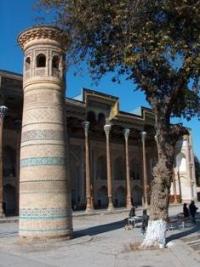You are here
Bolo hauz mosque in Bukhara.

Tours over architectural masterpieces of Bukhara.
“For everything in this journey of life we are on, there is a right wing and a left wing: for the wing of love there is anger; for the wing of destiny there is fear; for the wing of pain there is healing; for the wing of hurt there is forgiveness; for the wing of pride there is humility; for the wing of giving there is taking; for the wing of tears there is joy; for the wing of rejection there is acceptance; for the wing of judgment there is grace; for the wing of honor there is shame; for the wing of letting go there is the wing of keeping. We can only fly with two wings and two wings can only stay in the air if there is a balance. Two beautiful wings is perfection. There is a generation of people who idealize perfection as the existence of only one of these wings every time. But I see that a bird with one wing is imperfect. An angel with one wing is imperfect. A butterfly with one wing is dead. So this generation of people strive to always cut off the other wing in the hopes of embodying their ideal of perfection, and in doing so, have created a crippled race”
C. JoyBell C.
Excursion to Bolo hauz mosque in Bukhara.
Opposite the gates of the Arch, closing the Registan Square, the column aivan of the Bolohauz Mosque stretched in a wide front. This is the only monument preserved in the Registan. The picturesque mosque with a multi-column aivan, a miniature minaret near the pond laid out with a stone was the cathedral and served to perform five times of namaz.
It was formed around the old mosque, built in 1712 and became the second Juma mosque after the Kalyan mosque. The Friday prayers were attended by the emirs of Bukhara. The courtyards of madrasahs with hudjras adjoined it from the south and north.
The portal of the mosque, on the sides of which preserved maoilic inscriptions, is facing the Arch gate. On the solemn days here on the road, covered with carpets, the emir descended from Ark. In front of the aivan there are a house and a low minaret built by the folk master Shirin Muradov.
Under the wide dome is the main hall of the mosque, whose mikhrab niche is richly decorated with ganch stalactites. At the beginning of the XXth century, the facade of the mosque was decorated with a high wooden iwan.
Near the mosque on the shore of the reservoir in 1917, Usto Shirin Muradov built a small minaret, imitating Kalyan in form. The most striking feature of the mosque is the summer aivan decor with 20 wooden columns made of walnut, elm and poplar.
The greater length of the columns is provided by the connection of two trunks. Their mushroom-shaped stalactite capitals are decorated with colored inks. Cross beams divide a ceiling into multi-color rectangular cassettes.
This masterpiece of handicraft art has characteristic stalactite cavities in the middle of the star-shaped figure. The Bolo haus mosque is decorated with complex relief ornaments. Mihrab, a niche indicating the direction to Mecca, is decorated with delicate, charming patterns.
The portal with ganch plaster is located on the east side of the mosque, and its protrusions are decorated with ganch ornament. From the ceiling hanging chandelier. On both sides of the portal built two-story, with high niches Hujra.
Bolo Hauz Mosque (over the pool)is situated at Registan Square near Ark Citadel. The mosque is built in classic style of Central Asia: there is a winter building built in 1712, summer aivan of the beginning of XX century with sumptuous painted ceiling and ancient wooden columns.
Bolo-Hauz ensemble was built in the beginning of XVIII-th century and is regarded as a young building in comparison with other monuments of Bukhara. The mosque consist of minaret and a mosque itself, which are reflected on the waters of the pond (hauz)preserved till today.
This pond actually gave the name to the whole ensemble. Bolo-hauz is translated from Uzbek as “children pool”. Nearby the hauz there is a small minaret that was constructed in 1917 by the famous master Usto Shirin.
Due to the legend, Emir of Bukhara usually comes down to this mosque from the Ark fortress by the path covered with carpets for praying procedures. The most striking detail of the mosque is the decoration of aivan the columns of which are spliced from two trunks and had difficult stalactite capitals.
Authority:
V.G Saakov «History of Bukhara». Publishing house "Shark", 1996. «Bukhara. Masterpieces of the Central Asia». The historical guidebook across Bukhara. 2012. "Bukhoro. Bukhara" In the Uzbek, English and Russian languages. Publishing house "Uzbekistan", Tashkent 2000. Mukhammad Narkshakhi. History of Bukhara. Tashkent. 1897 (translator N.Lykoshina). V.G.Saakov "Architectural masterpieces of Bukhara. A Bukhara regional society "Kitabhon" Uzbek SSR, Exactly 1991 Robert Almeev. "History of ancient Bukhara". (Under edition of the Academician of the Academy of sciences of Republic Uzbekistan of Rtveladze E.V.).
Photos
Alexander Petrov.







